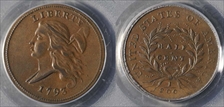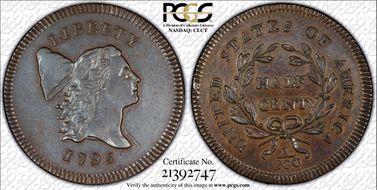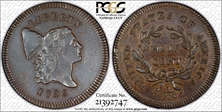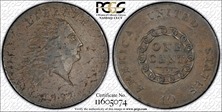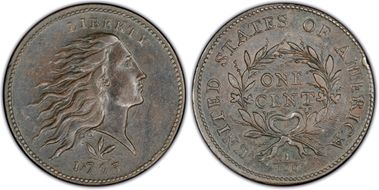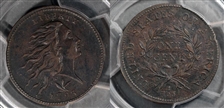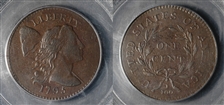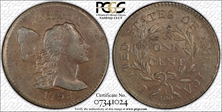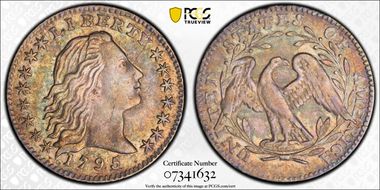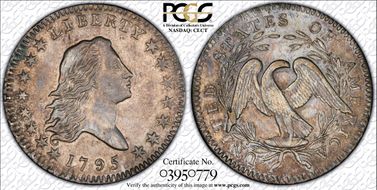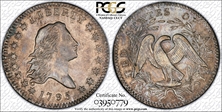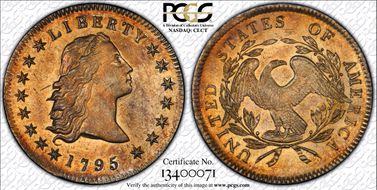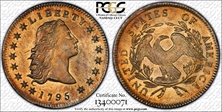Gobrecht's Raisinet Collection 的钱币相册
C-4, B-4, Low R.3. EAC 50, PQ! Manley Die State 2.0, with the die defect atop the 7. This wonderful example of this first year issue has nearly ideal color over smooth, blemish-free surfaces with well-defined, full flowing hair. It's an impressively sharp and smooth representative of this popular single-year type. Chocolate-brown dominates both sides, with a glimpse of deeper brown toning present on the lower left obverse and central reverse. Liberty's cheek and forehead display a hint of friction, but the designs are exquisitely impressed aside from minor softness on some of the letters in AMERICA. Marks are minor for the grade, and the only identifiers are two faint, superficial marks behind the cap, and two blemishes of similar small size below and between AM of AMERICA. These are inconspicuous because of subsequent natural toning, and the quality and beauty of the piece remains irrefutable. Thomas Jefferson made the half cent the lowest denomination in the 1784 “Notes on Coinage” that he submitted to the federal government. Eventually, after much delay and Congressional inaction, Jefferson's proposal emerged as the Mint Act of April 2, 1792. David Rittenhouse, Adam Eckfeldt, and Robert Birch combined to execute the design of the small copper coin with Birch and Joseph Wright engraving the dies. By May 1793 over 30,000 copper half cent planchets had been prepared and on July 20 the Philadelphia Mint coined its first 7,000 specimens. Mint employees produced a further 24,934 pieces on July 26 and the final 3,400 examples on September 18. Having delivered a total of 35,344 1793 half cents, the Mint closed on the latter date so that its staff could flee Philadelphia and its annual yellow fever epidemic.
1795 1/2 C Lettered Edge AU55 C-1, B-1, R.2. Toned a medium to dark brown in color and quite even. The strike is sharp throughout, quite an event as so many of the 1795 half cents come with poorly struck devices. Excellent surfaces are the rule, and this piece is a delight to study. There is a very faint scratch down Liberty's face below her eye, and for identification purposes a tiny planchet flake resides above the post of the E in STATES. A very scarce coin in this relatively lofty grade, with a high quality planchet and good overall eye appeal. From The Melrose Bay Collection
1795 1/2 C Lettered Edge AU55 C-1, B-1, R.2. Toned a medium to dark brown in color and quite even. The strike is sharp throughout, quite an event as so many of the 1795 half cents come with poorly struck devices. Excellent surfaces are the rule, and this piece is a delight to study. There is a very faint scratch down Liberty's face below her eye, and for identification purposes a tiny planchet flake resides above the post of the E in STATES. A very scarce coin in this relatively lofty grade, with a high quality planchet and good overall eye appeal. From The Melrose Bay Collection
1793 Chain 1C AMERICA AU53. S-3, B-4, Low R.3. EAC 40. Surfaces: The obverse surface has countless minute defects that appear to be almost entirely planchet flaws, representing an improperly refined strip of copper, a common problem in the first year of Mint operations. Sheet copper was not yet available from England, so available copper was scrap copper from local sources that Henry Voigt acquired. In his Encyclopedia of Large Cents, Breen discussed the problems with this locally available copper: "Scrap copper varied greatly in homogeneity, density, malleability, and hardness. This is partly from different trace elements and partly from the way the individual lumps had been treated in manufacture. This was a most unsatisfactory expedient; the coiner's department learned quickly that different ingots cast from it varied greatly , with far too many gas bubbles. Strip rolled from these ingots came out with too many cavities and laminations. Many surviving Chain cents accordingly show such flaws." The sophisticated collector will appreciate the planchet flaws as part of this coin's history and charm. A few tiny rim bumps are visible, and these appear to be the only post-strike imperfections. In direct opposition to the obverse, the reverse surface is nearly flawless. Only a few minute defects, rim flaws, and abrasions can be seen. Both sides have lovely medium brown color with traces of darker steel color on the high points. Considerable original mint frost remains, with splashes of lighter tan on the reverse, faded from original mint red. This example is a later die state. The obverse has prominent clash marks around and below the bust, and the reverse is flowlined with field roughening below UNITED STATES. The latest known die state of this variety, called Die State III in Breen's classification, displays heavy clash marks along Liberty's lips, chin, neck, and bust line. Breen suggested that these obverse clash marks, as seen somewhat on this example, were responsible for the "Liberty in chains epithet" sometimes given to the Chain cents. The Chain design was intended to show strength or unity of our new nation. Instead, the device was interpreted by many as representing slavery. Most of the mintage was lost or destroyed, so survivors are of various grades, usually lower quality. Porous or corroded pieces are frequently encountered. There is no question among specialists that Sheldon-3 is the most common Chain cent. Current rarity ratings for the Chain cent varieties suggest that the total surviving population of all varieties is 900 to 1,000 coins, with 400 to 500 examples of the S-3 and about 500 to 600 of all other varieties combined. Working under the assumption that the current rarity ratings are reasonably accurate, we can surmise that the original mintage occurred in about the same proportion. Approximately 18,000 examples of this die marriage were coined, with another 18,000 of the other three Sheldon numbers.
S-9, B-12, R.2. Noyes VF20; tied for CC-21. EAC VF25. PQ–. Variety: Horizontal stem parallel to the date. The bow is large and rounded. The obverse appears on S-8, S-9, and NC-4. The reverse appears on S-9. Vine and Bars Edge. The S-9 is the single most common Wreath cent variety by a wide margin. Surfaces: An attractive piece with smooth, hard, glossy surfaces. Both sides have mottled golden-brown and deep steel color. A few minor handling marks are visible on the obverse, with a small reverse edge bump over the M. Light corrosion is evident, primarily on the reverse. Full obverse and reverse borders are visible, with the reverse imperfectly centered. Both sides are sharply detailed, and the obverse and reverse types stand boldly against the field. Die State VII: The reverse has die cracks through R and CA of AMERICA, and from the left stem through UNIT. A late die state, although most of the individual die defects Breen describes are faintly visible. Census: Perhaps 10 examples are known in Mint State. This piece has considerable sharpness but is downgraded for various minor imperfections. Commentary: The S-9 is clearly the most common Wreath cent variety, and the only 1793 large cent of any design with a rarity rating less than R.3. Sheldon mentioned in Early American Cents that S.H. Chapman considered this variety to represent 35% of all existing Wreath cents. From a mintage of 63,353 Wreath cents, this would imply a "mintage" of about 22,000 coins. Raw material for copper coinage at the new Mint came from a variety of local sources, none particularly ideal, generally consisting of scrap, rough ingots, or sheet. In Breen's Large Cent Encyclopedia, contributor Craig Sholley wrote: "The locally obtained scrap proved to be especially troublesome. Copper is a difficult metal to properly melt and it is far more difficult to roll than silver or gold. The Mint, lacking both experience and proper equipment, was not prepared for either of these operations." The first of the two processes required that Mint personnel melt the metal and pour it into ingot molds, while watching for retained gas bubbles or impurities. Bubbles in the metal resulted in split planchets, laminations, or other defects to the finished coins. Impurities resulted in various streaks or discoloration spots. The other process was rolling the ingots into planchet strip of the appropriate width and thickness. The Mint used horsepower-operated rollers that were apparently poorly made. Coinage of the Wreath cents was suspended after the April 19 delivery while the rollers were repaired.
S-9, B-12, R.2. Noyes VF20; tied for CC-21. EAC VF25. PQ–. Variety: Horizontal stem parallel to the date. The bow is large and rounded. The obverse appears on S-8, S-9, and NC-4. The reverse appears on S-9. Vine and Bars Edge. The S-9 is the single most common Wreath cent variety by a wide margin. Surfaces: An attractive piece with smooth, hard, glossy surfaces. Both sides have mottled golden-brown and deep steel color. A few minor handling marks are visible on the obverse, with a small reverse edge bump over the M. Light corrosion is evident, primarily on the reverse. Full obverse and reverse borders are visible, with the reverse imperfectly centered. Both sides are sharply detailed, and the obverse and reverse types stand boldly against the field. Die State VII: The reverse has die cracks through R and CA of AMERICA, and from the left stem through UNIT. A late die state, although most of the individual die defects Breen describes are faintly visible. Census: Perhaps 10 examples are known in Mint State. This piece has considerable sharpness but is downgraded for various minor imperfections. Commentary: The S-9 is clearly the most common Wreath cent variety, and the only 1793 large cent of any design with a rarity rating less than R.3. Sheldon mentioned in Early American Cents that S.H. Chapman considered this variety to represent 35% of all existing Wreath cents. From a mintage of 63,353 Wreath cents, this would imply a "mintage" of about 22,000 coins. Raw material for copper coinage at the new Mint came from a variety of local sources, none particularly ideal, generally consisting of scrap, rough ingots, or sheet. In Breen's Large Cent Encyclopedia, contributor Craig Sholley wrote: "The locally obtained scrap proved to be especially troublesome. Copper is a difficult metal to properly melt and it is far more difficult to roll than silver or gold. The Mint, lacking both experience and proper equipment, was not prepared for either of these operations." The first of the two processes required that Mint personnel melt the metal and pour it into ingot molds, while watching for retained gas bubbles or impurities. Bubbles in the metal resulted in split planchets, laminations, or other defects to the finished coins. Impurities resulted in various streaks or discoloration spots. The other process was rolling the ingots into planchet strip of the appropriate width and thickness. The Mint used horsepower-operated rollers that were apparently poorly made. Coinage of the Wreath cents was suspended after the April 19 delivery while the rollers were repaired.
1795 1C Plain Edge AU58 S-78, B-8, R.1. This is one of the most common of all Liberty Cap large cent varieties and an ideal candidate for the date or type collector. For this die pairing, the peak of the 5 in the date just touches the bust truncation. Date and LIBERTY are closely spaced. ONE CENT is centered in the wreath and widely separated. ONE CENT is high in the wreath, as the engraver avoided placing CENT within the narrow space between the lower leaves, and the E in STATES is entered high. Specialists of 1795 cents know that the two most common varieties are S-76b and S-78, both Plain Edge varieties. The Lettered Edge varieties are significantly scarcer, as indicated by Guide Book prices. While none of the three collectible Plain Edge 1795 cent die pairs can be considered more than scarce, the type is more in-demand than the supply can handle, especially for better conditions such as Choice AU.
1795 1C Plain Edge AU58 S-78, B-8, R.1. This is one of the most common of all Liberty Cap large cent varieties and an ideal candidate for the date or type collector. For this die pairing, the peak of the 5 in the date just touches the bust truncation. Date and LIBERTY are closely spaced. ONE CENT is centered in the wreath and widely separated. ONE CENT is high in the wreath, as the engraver avoided placing CENT within the narrow space between the lower leaves, and the E in STATES is entered high. Specialists of 1795 cents know that the two most common varieties are S-76b and S-78, both Plain Edge varieties. The Lettered Edge varieties are significantly scarcer, as indicated by Guide Book prices. While none of the three collectible Plain Edge 1795 cent die pairs can be considered more than scarce, the type is more in-demand than the supply can handle, especially for better conditions such as Choice AU.
1795 1C Plain Edge AU58 S-78, B-8, R.1. This is one of the most common of all Liberty Cap large cent varieties and an ideal candidate for the date or type collector. For this die pairing, the peak of the 5 in the date just touches the bust truncation. Date and LIBERTY are closely spaced. ONE CENT is centered in the wreath and widely separated. ONE CENT is high in the wreath, as the engraver avoided placing CENT within the narrow space between the lower leaves, and the E in STATES is entered high. Specialists of 1795 cents know that the two most common varieties are S-76b and S-78, both Plain Edge varieties. The Lettered Edge varieties are significantly scarcer, as indicated by Guide Book prices. While none of the three collectible Plain Edge 1795 cent die pairs can be considered more than scarce, the type is more in-demand than the supply can handle, especially for better conditions such as Choice AU.
1795 H10C MS62. V-5, LM-8, R.3. The years 1795 and 1796 were busy and productive ones for the fledgling U.S. Mint. Director Henry DeSaussure--continuing his dual missions to produce circulating gold coinage and to improve the design of circulating silver coinage--employed the noted portraitist Gilbert Stuart in the summer of 1795 to fashion a new portrait of Liberty to replace the unpopular Flowing Hair design on silver denominations. From those sketches, artist John Eckstein prepared obverse device punches, and Chief Engraver Robert Scot prepared dies conforming to the Mint Act of 1792. The new Draped Bust, Small Eagle design was introduced first in 1795 on the silver dollar. Although no 1795 half dimes with the Draped Bust motif were coined, a 1795-dated obverse die of the new design was produced. The recorded mintage of 86,416 half dimes included both 1794- and 1795-dated pieces, but about three times as many 1795 pieces have been certified. The mintage of 1795 half dimes was divided into 10 different die marriages, most of them quite scarce. This coin is a representative of the scarce LM-8 variety. It is identifiable by the position of star 1 between curls 1 and 2 on the obverse and the wreath with no berries under the left wing of the eagle on the reverse. The LM-8 variety is one of the more available marriages, and is a popular choice with early type collectors. The number of high quality LM-8 half dimes is explained by its presence in a hoard mentioned by Walter Breen in his Proof Encyclopedia of more than 100 Mint State Flowing Hair half dimes, of this and two other varieties, discovered in the 1870s and dispersed by William Elliot Woodward around 1880, known as the Wadsworth-Rea hoard. On this variety there are seven curls, the first star points between curls 2 and 3, and the reverse shows the berries arranged 3-4 with none beneath the wings. There is no berry inside or outside of the U in UNITED, and a spike protrudes from the wreath and points between the first T and A of STATES. The bold diagnostic obverse die crack extends from the upper rim to Y in LIBERTY to the nose and then across the neck to the top of the 7 in the date. This variety is most easily attributed by the lack of berries around the lower left portion of the wreath and the relative position of the lowest outside left leaf relative to the U in UNITED. The die crack through the Y in LIBERTY also confirms this die pairing. The present example is sharper than most and centered, normally not seen on most early Bust design half dimes. No adjustment marks are apparent on either side of this coin.
1795 H10C MS62. V-5, LM-8, R.3. The years 1795 and 1796 were busy and productive ones for the fledgling U.S. Mint. Director Henry DeSaussure--continuing his dual missions to produce circulating gold coinage and to improve the design of circulating silver coinage--employed the noted portraitist Gilbert Stuart in the summer of 1795 to fashion a new portrait of Liberty to replace the unpopular Flowing Hair design on silver denominations. From those sketches, artist John Eckstein prepared obverse device punches, and Chief Engraver Robert Scot prepared dies conforming to the Mint Act of 1792. The new Draped Bust, Small Eagle design was introduced first in 1795 on the silver dollar. Although no 1795 half dimes with the Draped Bust motif were coined, a 1795-dated obverse die of the new design was produced. The recorded mintage of 86,416 half dimes included both 1794- and 1795-dated pieces, but about three times as many 1795 pieces have been certified. The mintage of 1795 half dimes was divided into 10 different die marriages, most of them quite scarce. This coin is a representative of the scarce LM-8 variety. It is identifiable by the position of star 1 between curls 1 and 2 on the obverse and the wreath with no berries under the left wing of the eagle on the reverse. The LM-8 variety is one of the more available marriages, and is a popular choice with early type collectors. The number of high quality LM-8 half dimes is explained by its presence in a hoard mentioned by Walter Breen in his Proof Encyclopedia of more than 100 Mint State Flowing Hair half dimes, of this and two other varieties, discovered in the 1870s and dispersed by William Elliot Woodward around 1880, known as the Wadsworth-Rea hoard. On this variety there are seven curls, the first star points between curls 2 and 3, and the reverse shows the berries arranged 3-4 with none beneath the wings. There is no berry inside or outside of the U in UNITED, and a spike protrudes from the wreath and points between the first T and A of STATES. The bold diagnostic obverse die crack extends from the upper rim to Y in LIBERTY to the nose and then across the neck to the top of the 7 in the date. This variety is most easily attributed by the lack of berries around the lower left portion of the wreath and the relative position of the lowest outside left leaf relative to the U in UNITED. The die crack through the Y in LIBERTY also confirms this die pairing. The present example is sharper than most and centered, normally not seen on most early Bust design half dimes. No adjustment marks are apparent on either side of this coin.
1795 50C 2 Leaves AU55. O-102, R.4. This piece is an intermediate die state, the obverse meeting Overton's requirements for O-102a and the reverse perfect as an O-102. It is also one of the finest known examples of the die marriage. In the fourth edition of Overton, Don Parsley recorded the Condition Census as 55, 45, 40, 30, 30. The finest examples to appear in recent auctions (and the only AU grade coins) are an AU55 ANACS piece that Heritage sold in November 2003 and an uncertified AU50 sold by Stack's in May 2001. Each side has a few minor scuffs and abrasions, but the overall eye appeal of this example is excellent. Satiny pale gray surfaces exhibit sharp design features with nearly full luster, accented by delightful gold and iridescent toning.
1795 50C 2 Leaves AU55. O-102, R.4. This piece is an intermediate die state, the obverse meeting Overton's requirements for O-102a and the reverse perfect as an O-102. It is also one of the finest known examples of the die marriage. In the fourth edition of Overton, Don Parsley recorded the Condition Census as 55, 45, 40, 30, 30. The finest examples to appear in recent auctions (and the only AU grade coins) are an AU55 ANACS piece that Heritage sold in November 2003 and an uncertified AU50 sold by Stack's in May 2001. Each side has a few minor scuffs and abrasions, but the overall eye appeal of this example is excellent. Satiny pale gray surfaces exhibit sharp design features with nearly full luster, accented by delightful gold and iridescent toning.
B-5, BB-27. R-1. An absolutely lovely coin, the visual appeal of which easily transcends its numerical grade. Delicately varying shades of golden toning aptly accent assertively struck, fully vibrant underlying surfaces. The fields exhibit an exceptionally atypical degree of reflectivity that only further heighten a bold strike. In fact, this extraordinary luster causes the viewer to look twice in case they have somehow confused this outstanding example with a Morgan dollar! Its visual allure surpasses most mint state survivors of this type.
B-5, BB-27. R-1. An absolutely lovely coin, the visual appeal of which easily transcends its numerical grade. Delicately varying shades of golden toning aptly accent assertively struck, fully vibrant underlying surfaces. The fields exhibit an exceptionally atypical degree of reflectivity that only further heighten a bold strike. In fact, this extraordinary luster causes the viewer to look twice in case they have somehow confused this outstanding example with a Morgan dollar! Its visual allure surpasses most mint state survivors of this type.




















